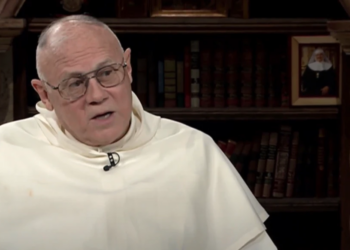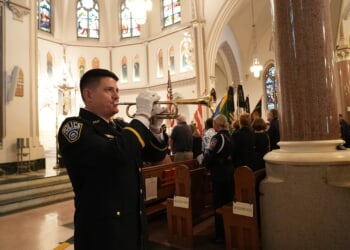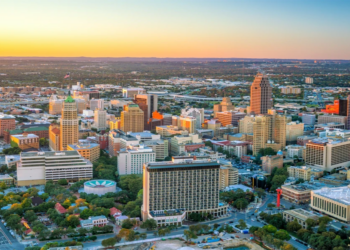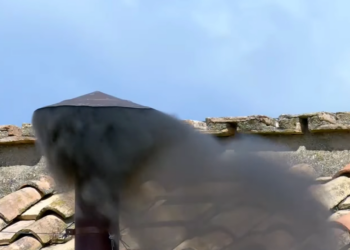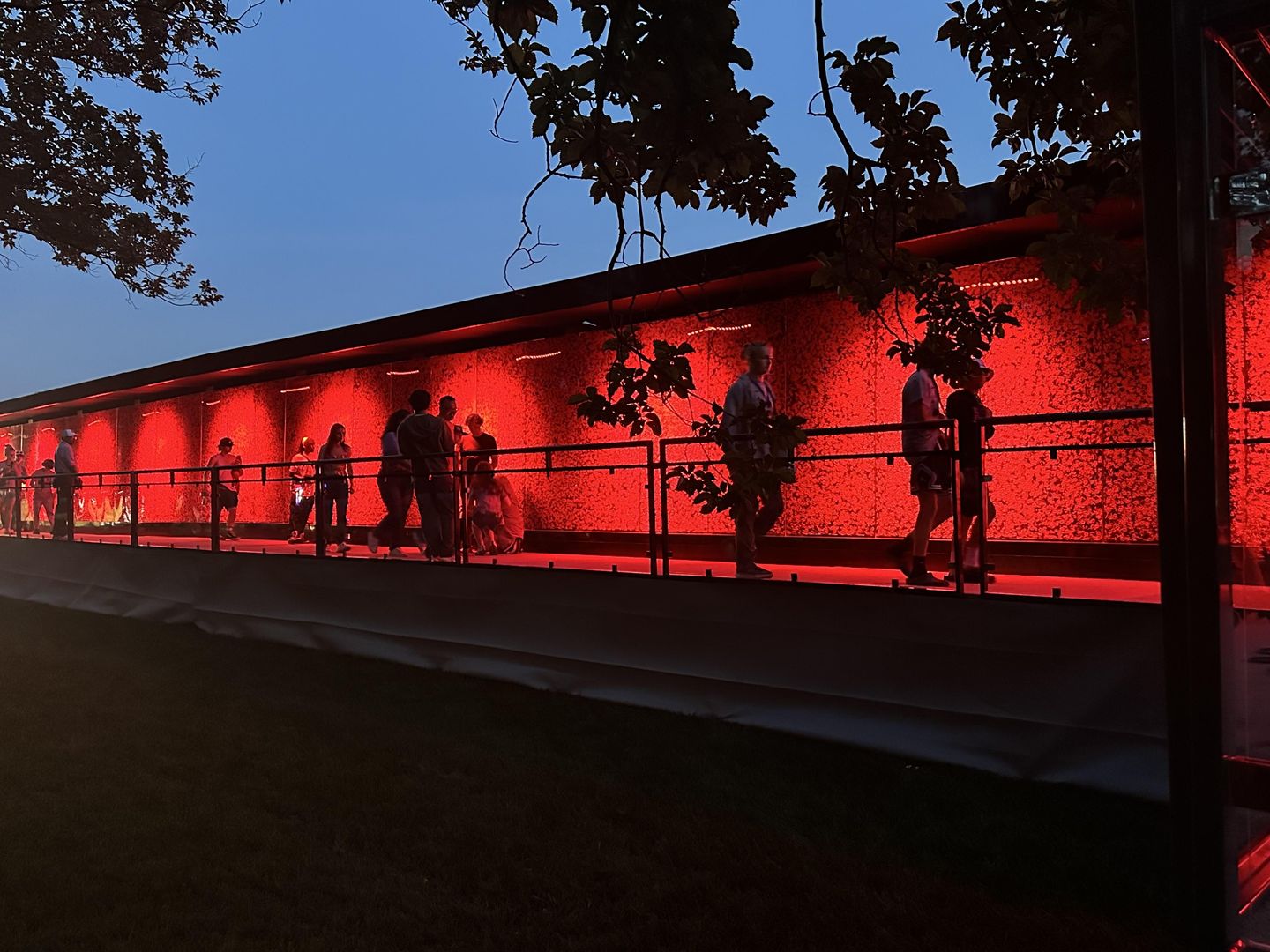
Memorial Day isn’t just the unofficial start of summer or an opportunity to test out a new gas grill with a feast of hot dogs and hamburgers.
The Poppy Wall of Honor returned to the National Mall over the Memorial Day weekend to honor more than 600,000 American service members who have given their lives to the nation since World War I.
One side of the 133-foot-long wall near the base of the Lincoln Memorial features educational panels about the conflicts the U.S. has fought in since World War I and the number of troops killed in action, from about 450,000 in World War II to 350 during Operation Desert Shield and Desert Storm.
The other side of the wall showcased 600,000 poppies pressed between glass, a blazing wall of red that stretched the length of the installation.
“Each one represents an individual who gave their life in defense of the nation since World War I,” said retired Army Maj. Gen. John Richardson, head of military affairs for USAA, which sponsors the wall.
“From World War I through the Global War on Terror, 6000,000 Americans have made the ultimate sacrifice for our freedom and in defense of our Constitution,” said Gen. Richardson, a former commander of the Army’s 1st Cavalry Division.
The display of a red poppy as an enduring symbol of the First World War is more closely associated with the British. Canadian Army doctor John McCrae saw the field of poppies churned up by the fighting and shelling on the Western Front. It was the inspiration for his 1915 poem, “In Flanders Fields.”
“In Flanders fields, the poppies blow
Between the crosses, row on row,
That mark our place; and in the sky
The larks, still bravely singing, fly
Scarce heard amid the guns below…”
For years after World War I, the victorious allies all celebrated Armistice Day on November 11. The British Commonwealth countries later called it Remembrance Day, while it became Veterans Day in the U.S. The first national observance of Memorial Day – then called Decoration Day – was on May 30, 1868 to honor the Union soldiers killed during the Civil War. After the two world wars broadened its scope to honor all U.S. war dead, Congress in 1968 changed its observance to the last Monday in May. In 1971, the name was standardized as “Memorial Day.”
The use of poppies fell out of common practice in the U.S. once Armistice Day became Veterans Day, which honors everyone who served in the military, both living and dead. But since the 1970s, veterans groups like the American Legion and the Veterans of Foreign Wars have been pushing to bring it back as a symbol for Memorial Day.
Kenny Jary was a sailor in the U.S. Navy from the late 1950s to the mid-1960s. He came to the Poppy Wall of Honor to honor all of the nation’s war dead and his fellow veterans who served in uniform during the Cuban Missile Crisis in October 1962.
“I came here to get an education about the poppies. I had never heard of the ‘Poppy Wall,’” Mr. Jary said. “I’m just so proud to be here.”
Gen. Richardson, who served multiple combat tours in Iraq and Afghanistan, said the Poppy Wall of Honor has a dual purpose. The side bedecked with crimson flowers is for remembrance and honor, while the other side is about education.
He doesn’t begrudge people who want to simply enjoy the three-day weekend, however.
“That’s what the 600,000 Americans who died were fighting for. They did it so that we ‘can’ gather together in the backyard to kick-off summer,” Gen. Richardson said. “All we ask … is to take a moment on that weekend to remember, honor, and thank those who made that sacrifice.”
Eduardo Hernandez and his son, Alexander, stopped by the Poppy Wall of Honor during the family’s two-week trip to Washington from their home in Chattanooga, Tenn.
“Every day we’re doing an experience or a museum. Today, we’re going around the Mall, hitting all the monuments, and just educating him on the history,” said Mr. Hernandez, a veteran of the Army and the Air Force who fought in uniform during the Global War on Terror.
“His grandfather was in World War II. History is more relevant when he has a connection to it,” he said. “We’re just trying to lay the foundation to bring up a good person.”
Mr. Hernandez said the site of the wall covered in well over half a million poppies was “pretty intense.”
“It’s a good reminder that there’s a cost to everything,” he said. “It’s important that knowledge, history and heritage is passed on to the next generation so it’s not forgotten.”
Alexander, 8, said the Poppy Wall of Honor was both “brutal” and “kind of cool.”
“I know for a fact that my teacher would never teach me this,” he said.
The Department of Veterans Affairs is hosting Memorial Day ceremonies over the weekend at more than 130 VA national cemeteries across the country. They expect at least 100,000 people to attend.
“I encourage Americans to join us at VA cemeteries across the country … to reflect on the tremendou debt we owe these fallen warriors,” said VA Secretary Doug Collins. “Their sacrifices have helped make America the greatest place on Earth, and their legacies of courage and commitment inspire us to reach new heights.”





![CNN’s Jennings Roasts Biden's 'The View' Interview Defenders, Calls Out Coming Meltdown [WATCH]](https://www.right2024.com/wp-content/uploads/2025/04/Scott-Jennings-Wrecks-Former-Hillary-Spokesperson-with-One-Question-on-350x250.jpg)
![Frontier Airline Agents Fired After Video Mocking Passenger on Camera Goes Viral [WATCH]](https://www.right2024.com/wp-content/uploads/2025/05/Frontier-Airline-Agents-Fired-After-Video-Mocking-Passenger-on-Camera-350x250.jpg)

![Stephen A. Smith Goes Ballistic on DeMS-13 Senator Van Hollen [WATCH]](https://www.right2024.com/wp-content/uploads/2025/05/Stephen-A-Smith-Goes-Ballistic-on-DeMS-13-Senator-Van-Hollen-350x250.jpg)

![Dem Rep Caught on Bodycam Physically Attacking Law Enforcement at ICE Detention Facility [WATCH]](https://www.right2024.com/wp-content/uploads/2025/05/Dem-Rep-Caught-on-Bodycam-Physically-Attacking-Law-Enforcement-at-350x250.jpg)
![Minnesota Officials Panicking Over Derek Chauvin Pardon Speculation, Potential Unrest [WATCH]](https://www.right2024.com/wp-content/uploads/2025/05/Minnesota-Officials-Panicking-Over-Derek-Chauvin-Pardon-Speculation-Potential-Unrest-350x250.jpg)
